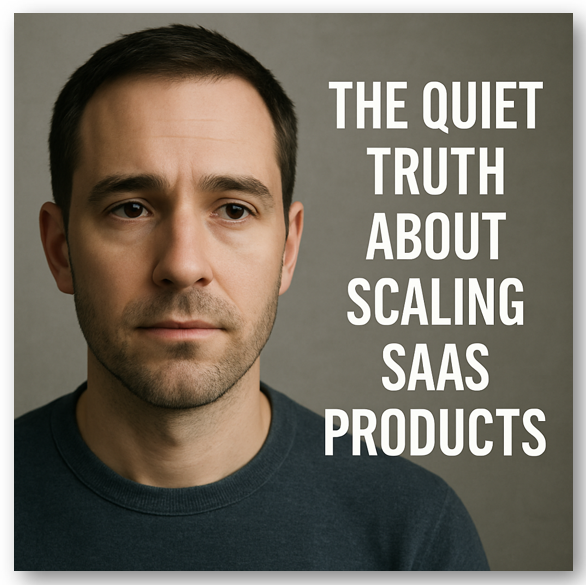Sonu Goswami The Hidden Edge Most SaaS Founders Miss
After working with early-stage SaaS founders, I found the real growth differentiator isn’t product-market fit — it’s something deeper.

The Hidden Edge Most SaaS Founders Miss (And Why It Matters More Than PMF)
I’ve spent the past two years deep in the trenches of SaaS content strategy, working with founders at different stages — from pre-revenue to scaling their first major growth phase.
And I keep seeing the same pattern.
Two founders build similar tools. Same market, similar features, even similar pricing. One struggles to hit $10K MRR after 18 months. The other quietly scales past $100K.
The difference isn’t their product. It’s not their marketing budget. It’s not even their team.
It’s how intimately they understand their market.
The Real Moat: Founder-Market Fit
Everyone obsesses over product-market fit. But there’s something that comes before PMF — something that makes achieving it inevitable rather than accidental.
Founder-Market Fit.
This isn’t about having a great product for your market. This is about being your market. Or being so close to it that you feel their pain in your bones.
When you have true founder-market fit, you don’t guess at features. You don’t A/B test messaging for months. You don’t wonder if your pricing makes sense.
You know.
What This Looks Like in Practice
I’ve seen this play out in my client work:
The Financial Planning SaaS: Founder spent 8 years as a CFO at high-growth startups. When he built his budgeting tool, he didn’t research what features CFOs wanted — he built what he desperately needed but couldn’t find. The messaging wrote itself. The pricing was obvious. First customer signed up within weeks of launch.
The Design Agency Tool: Built by someone who ran a 15-person design team. She knew exactly when designers got frustrated, which handoffs broke, what made clients happy. Her tool solved workflow problems she’d personally wrestled with for years. No customer interviews needed — she’d been conducting them accidentally for a decade.
The Developer Analytics Platform: Created by a former VP of Engineering who’d managed 50+ developers across three companies. He understood not just what metrics mattered, but when they mattered and why teams ignored them. His onboarding flow reflected real-world adoption patterns he’d witnessed firsthand.
Notice the pattern? None of these founders “found” their market. They already were their market.
The Content Marketing Tell
Here’s how I spot founder-market fit during content audits:
Strong Founder-Market Fit:
- Blog posts read like internal team discussions
- Use cases feel lived-in, not researched
- Messaging hits emotional triggers I wouldn’t think to test
- Content addresses objections before prospects voice them
Weak Founder-Market Fit:
- Content sounds like everyone else in the space
- Examples feel generic or pulled from case studies
- Messaging focuses on features, not outcomes
- Everything needs extensive user research to validate
The difference is visceral when you see it.
The Unfair Advantages This Creates
When you have deep founder-market fit, everything becomes easier:
Faster iteration: You don’t need focus groups to know what to build next. You feel the market’s needs intuitively.
Lower CAC: Your messaging resonates immediately because it reflects real pain, not assumed pain.
Higher retention: You solve problems users didn’t even know they had because you’ve lived those problems.
Natural evangelism: Customers become advocates because you “get it” in ways competitors don’t.
Clearer positioning: You don’t wonder how to differentiate — you know exactly what makes you different.
The Test: Could You Sell Before You Build?
Before writing a single line of code, ask yourself:
- Could you list 20 specific use cases without research? Not “project management” but “when Sarah needs to update stakeholders on sprint delays without derailing the standup.”
- Do you know their current tools — and exactly why they hate them? Not just “Excel is limited” but “Excel breaks when Jim from finance adds that pivot table that crashes everyone’s version.”
- Could you write their landing page from memory? Including the exact words they use to describe their problems?
If you’re nodding yes, you likely have strong founder-market fit. If you’re hesitating, you might be building on assumptions rather than experience.
Why This Matters More in 2025
The SaaS landscape has fundamentally shifted. Capital is tighter. Customer acquisition costs are higher. Product differentiation is harder.
In this environment, the founders who win aren’t those with the best products — they’re those with the deepest market understanding.
Because when you truly understand your market, you don’t just build better products. You build inevitable products. Products that feel like they were designed specifically for your users’ unique situation.
That’s not marketing. That’s founder-market fit.
What’s your take? Have you seen examples of founders who clearly “got” their market in ways that translated to business success? I’d love to hear your thoughts.

